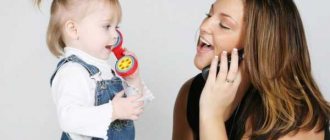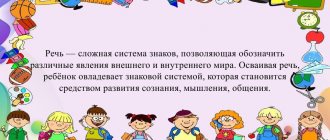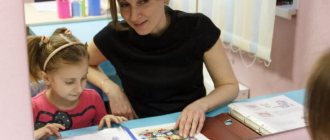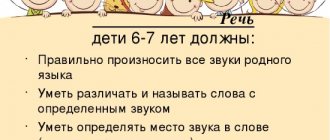Article:
A child’s speech at 1 year of age depends on how the preparatory work for its development was carried out from birth to one year.
Humming, babbling and pronouncing the first words prepared the articulatory apparatus for more complex work; the baby's acquaintance with the objects of his immediate environment enriched his passive vocabulary. At the age of one year, the baby already knows the meanings of many words, the active dictionary contains 10–25 words, and he begins to use speech as a means of communication. He can pronounce words correctly (mama, lalya, baba), babble (pa, ma, bah), partially reproduce the forms of words (“kach” - swing, “zya” - impossible), and imitate the voices of animals and the sounds around him (mu -mu, boo-boo, pee-pee, beep).
At this stage, it is already possible to determine whether there are speech problems. Unlike specialists, it can be difficult for parents to see them, but below we will tell you what signs you can use to independently identify speech problems in your baby.
Passive and active vocabulary
During this period, attention is drawn to such a characteristic feature as imitation of the words of adults. The baby repeats not only familiar words, but also previously unknown ones. These could be words addressed to the child, or words that he heard from others. Such active imitation can be noticed already from 1 year 5 months. Here it is important not to coo with children, faking your speech in “childish” language, but to give an example of the correct pronunciation of words.
Starting from the first year of life, the understanding of words grows; the baby is familiar with the names of objects in his immediate environment, the names of objects, animals and other objects that are most often shown to him in pictures in children's books, on the street. The baby loves to look at bright colored book illustrations. Adults should maintain this interest by choosing clear pictures.
When commenting on illustrations to a child, you need to speak precisely, in simple words, try to denote the object with one, constant word, so that the meaning of the picture is not lost in the stream of speech of an adult. For example, while the word monkey is used to describe monkeys and gorilla.
By the age of one and a half years, a child’s active vocabulary is 20–30 words; its sound composition is still simple. Thanks to the desire to imitate the speech of adults, by the end of the second year the baby increases the number of spoken words tenfold. Speech is dominated by nouns, but there are also verbs (2-3 times less of them) and adverbs (there, here, here).
Occasionally, by the age of two, the use of adjectives can be found in children's speech; this feature will continue to persist into early preschool age. Personal pronouns are often found in a child’s speech and are easily used (I, you, he, she).
Grammatical structure of speech and sound pronunciation
After one and a half years, the ability to change words in the simplest ways appears, linking them into one phrase (give me a doll - “give me a ku”). Monosyllabic sentences are most often used. In such primitive sentences, one word can be used in different meanings. By pronouncing the word “mu,” in one case the child wants to be given a toy, and in another, with the same word, he draws the adult’s attention to the eyes or horns of the toy cow that he is holding in his hands.
By the end of the second year of life, sentences may contain three or four words. Sentences can be both interrogative and exclamatory. The question words themselves are not yet available to the child; he expresses the question by the intonation with which he pronounces such a sentence. There are no prepositions in the words yet either (“Seva bi-bi” - Seva has a typewriter).
All vowel sounds are already pronounced by the baby in the second year of life. Its articulations and some consonant sounds are available: m, p, k, t, d, n, f, x, b, g, v, y. The clarity of their pronunciation depends on the place of the sound in the word and the number of syllables in it. In simple words of one or two syllables, all sounds are pronounced correctly (Katya, dad, Tanya, Vova). These same sounds are “swallowed” and distorted in more complex words (pisina - machine). Combinations of two consonant sounds next to each other (heb - bread) are also difficult for the baby, especially if these are sounds that are difficult to pronounce, for example: s, sh, r, l.
Different rates of speech acquisition by children of the same age become noticeable. This depends on the individual characteristics of the baby, heredity, and diseases suffered in early childhood. Of great importance is the intensity of communication between adults and the child, how the child’s speech development is stimulated at 1 year of age.
Norms of speech development in young children
When assessing a child’s speech at 1 year of age and throughout the second year of life, one should rely on existing criteria for correctly occurring speech development.
- 1 year. The emergence of the first words.
- 1 year 6 months – 1 year 9 months: Smooth increase in the number of words used to several dozen.
- Combining words into one inconsistent phrase.
- Pronunciation of small words, general softness of speech.
- The child calls himself in the 3rd person.
- The appearance of a question using an intonation rise at the end of a word or phrase.
- Babbling during play activities.
- Finishing a familiar phrase.
- Listening carefully to your favorite book.
- "Lexical explosion".
Thus, with unimpaired speech development, children overcome a difficult path in the second year of life - from the appearance of the first word to the construction of a full-fledged sentence.
Norms of speech development in the second year of a baby’s life
Assessing a child’s speech at one year of age is very problematic: the guidelines for its development are very arbitrary and a delay in speech activity is acceptable. You can give approximate norms at the end of the second year of life:
- the baby answers simple questions;
- he can carry out a simple order, for example, take a cup to his grandmother, give him an item or a toy;
- the child easily repeats simple phrases and simple words after adults;
- all vowels and most consonants are available to its pronunciation;
- by the age of one and a half years, the baby combines two words into a sentence, and by two years, he constructs a sentence of 3–4 words;
- he actively and on his own initiative enters into communication with other children and familiar adults;
- he can ask a question using intonation;
- the child is able to pronounce at least 50 words, more often 200–300;
- begins to use singular and plural nouns (cube - cubes), diminutive suffixes (house - house);
- he can understand and follow two-step instructions: “Take the spoon on the table and take it to dad”;
- the baby can show two or three parts of the body or more;
- listens to nursery rhymes, fairy tales, poems, tries to remember small pieces.
If in the list above you see an item that your baby does not meet, it is worth closely observing the child, assessing whether he strives to communicate with others, whether he understands speech addressed to him. It is possible that the baby has a slight delay in speech development.
Features of speech development in children
The development of a child’s speech at an early age is closely related to his practical activities. He begins to walk independently, constantly interacts with objects, learns from an adult and remembers their names, and learns to use new words on his own. All this stimulates communication.
During a flower arranging lesson, a child can learn a lot of words: flower, stem, petals, rose, glass, water, pot, earth, etc. Next time he will be able to repeat those he has already memorized and learn new ones
From 1 to 2 years
By the end of the first year of life, the child begins to develop an active and passive vocabulary. The active vocabulary is the words that he can already pronounce, and the passive vocabulary is the words that he understands. By 12–14 months, the active vocabulary can contain from 4 to 15 words. The passive vocabulary is approximately 3 times wider: there are more words that a child understands than those that he can pronounce.
At the same age, speech moves to a new stage: now the child perceives it as a means of communication. If previously the baby perceived words as single inarticulate sound complexes, now he separates them in the parent’s speech. As a result, he begins to actively pronounce the words he knows, addressing them to an adult.
To get acquainted with an object, the child reaches out to it, accompanying his actions with facial expressions and sounds, and cries or is capricious if he does not get what he wants. Then he shifts his focus to the parent: he turns his gaze from the object to the adult so that he can get it, or points to the object with gestures.
The baby pronounces words meaningfully and with reference to the situation, but their meanings are very unstable. This happens because he masters speech associatively: for example, seeing a bird, he points at it and says “kar”. Then he can see the image of a bird on a coin - he will also call this coin “car”. Then he sees a bird wearing a cuckoo clock, and the clock becomes “car”.
From 1.2 to 1.3 years, active imitation of an adult begins. The child repeats words and phrases: looks at the parent, watches the movements of his lips, jaws and tongue, tries to pronounce a word and name an object that an adult previously showed or gave him to hold in his hands. Gradually the baby gets it.
He then moves on to using words meaningfully. However, the word still has a specific object behind it: for example, the word “cup” means only the cup from which the child eats. All the other cups he saw do not belong to this word. Over time, the child, coming into contact with objects that are similar to each other, notices the similarities and begins to call these things with a common word (“cups” become many). And soon, by about one and a half years, verbs appear in speech.
From 1.3 to 1.8 years, the baby begins to use words, putting into them the meaning of entire sentences. Gestures and facial expressions help others understand his speech.
When a baby reaches for a toy and says “mom,” he means “mom, give me the toy.” So, the word “mother” can have completely different meanings depending on the context, situation
After 1.5 years , movements, sounds and gestures are increasingly replaced by words, which turn into a full-fledged means of communication. At this stage, it is especially important that there is no baby talk with the child, because the baby learns the forms of words that he hears from an adult. It is also important that there is no information overload - this often leads to delays in speech development. New words and phrases should be introduced gradually.
From 1.6 to 1.8 years, a period of latent speech development occurs. People around do not notice any significant changes, but the child experiences an accumulation and development of speech, which does not appear outwardly.
From 1.8 to 1.10 years, two-word sentences appear in speech. The child constructs phrases that include a noun and the required action. For example, “Mom, yum-yum,” and the mother guesses that the child wants to eat.
After 1.10 years, sentences begin to consist of three words or more. The child begins to say his name. While he is talking about himself in the third person: “Masha wants to eat.”
From 2 to 3 years
At the age of 2, a child experiences a “speech explosion”: his vocabulary sharply expands—the active dictionary now contains up to 200–300 words. The kid constantly asks questions: “What is this?” He wants to hear as many new words as possible, and these words are instantly included in his speech, so it is important to answer every question.
At the same age, the unification of two mental functions occurs - thinking and speech. Speech becomes intellectual, and thinking becomes verbal. The child begins to think in words.
In the period from 2 to 3 years, the number of sentences increases, and the words in them begin to correctly agree with each other. Also, at the age of about 2 years and in the third year of life, the child begins, on his own initiative, to reflect in speech everything that he perceives in the world around him. In this way, descriptive speech arises, and the baby begins to distinguish objects by characteristics, understand the difference between “many and little” and transfer all this into speech.
The child begins to reproduce poems, songs, and fairy tales he has heard. He has a mechanical memory, which is actively involved in the work of speech. Understanding of speech continues to develop: by the end of the second year it is based on the correct perception of all sounds of the native language
By about 3 years of age, active and passive vocabulary level off . That is, the child can pronounce all the words that he understands. He immediately begins to reproduce everything he hears.
Through words, a child controls the attention of an adult, and an adult can also attract the attention of a child with the help of words. Behavior begins to obey verbal instructions - the baby understands what the adult requires of him. In the third year of life, the baby, according to the instructions of an adult, can not only begin, but also stop his activities, which creates new opportunities for his communication with the adult, raising the baby and learning the rules of behavior.
The most important achievement in a young child’s understanding of speech is the formation of speech attention: the ability to focus on the sound side of a word, listen to another person, and understand what he is talking about. This is the starting point for further speech development. The child begins to understand the content of short literary works, texts, poems, and at 3 years old he already perceives an adult’s story, which consists of 3-4 sentences. It is better when all the texts are related to his personal experience - situations are described that are familiar to him and evoke an emotional response in him.
Until the age of three, a child will be more captivated by the story of how children play hide and seek than by the adventures of talking animals.
Symptoms of delayed speech development in a baby
How to understand that a one-year-old child has a delay in speech development? This question interests many parents, and often moms and dads rush from one extreme to another. Some, seeing how their child’s peers express themselves fluently and freely, anxiously listen to the speech of their child, who has not mastered even half of this vocabulary. Others, relying on the stories of those who tell how their silent children suddenly spoke at 3, 5, 6 years old, do nothing and wait for the same miracle, and then face the problem of a serious delay in the development of their baby.
The age from one to two years is a kind of milestone when it becomes clear whether a child’s speech is developing normally, or whether the child has one of the following pathologies:
- motor alalia
- sensory alalia,
- dysarthria,
- aphasia,
- rhinolalia,
- hearing loss, or lack of hearing,
- delayed speech development,
- general speech underdevelopment.
At two years old, it is necessary to have your baby examined by a specialist if he has the following symptoms:
- the child is silent or babbles in one language he understands;
- when asked what his name is, he turns away;
- the baby does not turn to an adult when he needs something, but hums or points with his finger;
- the child understands what is said to him, but cannot formulate the statement himself;
- at first speech appeared, there were words or even phrases in it, and then it disappeared, and the child practically fell silent;
- by 2 years of age there are almost no words in speech.
Based on the results of the examination, at two years of age it is advisable to begin stimulating speech development, and parents themselves can make significant progress in this direction. Many simply do not know what and how to do, so it is recommended to go for a consultation with a speech therapist, psychologist or defectologist - you can work with them from the age of 2.
Self-diagnosis of speech delay
Without being specialists, parents are unlikely to be able to independently determine the cause of the speech defect. They only have access to simple diagnostics. Parents can determine:
- Is the baby's hearing impaired?
- What is the state of the child’s gross and fine motor skills?
- whether the mobility of his articulation organs is preserved,
- to what extent he understands the speech addressed to him.
Hearing test
Hearing impairment is a significant cause of delayed speech development. Without hearing the correct pronunciation of words, the baby will not be able to pronounce them. You can suspect such a pathology if the following symptoms appear over the course of a year:
- the baby does not respond to quiet sounds that are heard outside his field of vision;
- it does not turn towards the source of the sound;
- the child does not show interest in music, the sounds of operating household appliances, electronics;
- the baby does not understand when he is addressed;
- he does not imitate onomatopoeia, there is no babble or simple words in his speech;
- the child does not use his voice to attract the attention of adults.
If you have doubts, you can check your baby’s hearing yourself. To do this, you need an adult assistant and a separate room, protected from extraneous noise. The baby should be invited to play with sounding toys with his mother. Next, the adult uses them to make sounds behind the baby’s back at a distance of at least 6 meters, so that he does not see the source of the noise. If there is no reaction, the distance is reduced by one meter, getting closer to the child with each stage.
You can start the examination by whispering behind the baby’s back, depicting an unusual combination of sounds that should attract the child’s attention. Then these sounds or the baby’s name are repeated in a voice at normal volume. The same procedure is carried out a few days later. If you suspect absence or decreased hearing, you should show the child to an otolaryngologist.
Diagnostics of fine and gross motor skills
It is not for nothing that such great importance is attached to the examination of motor skills. The areas of the brain responsible for the development of speech and fine motor skills of the child are located next to each other. There are no problems with fine motor skills, which means that the mechanisms of speech emergence are preserved, and, most likely, the problem does not lie in the field of neuropathology. Uncertain and uncoordinated movements, inability to make precise movements with the hand and fingers - you need a consultation with a neurologist and a thorough diagnosis.
Indicators of the development of general motor skills by the end of the child’s second year of life:
- He can run;
- climbs stairs well, stepping on each step in turn with one foot;
- jumps up low or jumps over a very low obstacle;
- kicks the ball;
- steps over objects;
- marches, although not too deftly;
- may back away.
Achievements in the development of fine motor skills in a two-year-old child:
- tries to stop the ball rolling towards him;
- he can stack from 4 to 6 cubes on top of each other (“building a tower”);
- the child draws vertical lines or simply “doodles,” although he often holds the pencil or felt-tip pen incorrectly;
- he has a well-developed “tweezer grip,” when the baby takes very small parts of toys or pieces of food with two fingers;
- he strings the rings of the pyramid onto the pin of the stand;
- tears small pieces from a sheet of paper or a piece of plasticine.
To determine the level of development of motor skills, there is no need to organize a special examination; it is enough to carefully observe the child’s movements while awake.
Diagnostics of articulation organs
Anomalies in the structure of the speech organs and impaired mobility can affect the ability to pronounce certain groups of sounds. To detect pathology, it is enough to check the structure of the tongue, jaws, lips, and palate.
Possible problems:
- progeny - the lower jaw is pushed far forward relative to the upper jaw;
- prognathia – the upper jaw protrudes forward;
- open bite - a gap is visible between the closed teeth;
- high and narrow palate (“Gothic”);
- shortened frenulum of the tongue, it is difficult for the baby to lift the tongue upward, it begins to bifurcate in the child like a snake;
- massive or very small tongue.
In addition to these defects, parents may notice increased salivation, tongue trembling, limp lips, and a constantly slightly open mouth. If you have such symptoms, you should immediately contact a specialist. Failure to carry out timely corrective measures can lead to the development of mental retardation and even mental retardation.
Testing speech understanding
To make sure that the child understands the speech addressed to him, he is asked to complete several tasks in a playful way:
- offer to choose one toy from several laid out in front of the baby;
- understands and selects red, yellow, blue and green objects;
- assemble a matryoshka or pyramid
- ask to show things that he uses in everyday life: a spoon, a cup, a chair, slippers;
- offer to show yourself or the doll body parts;
- ask to find an object or action in the picture (they can be cut out from unnecessary magazines and pasted on cardboard);
- offer to fulfill a simple request: bring a book, come closer, give a toy.
The absence of defects in the organs of articulation and understanding of the speech of others with underdevelopment of speech skills may indicate a tempo delay in speech or general underdevelopment of speech. Stimulating classes with a specialist, started as early as possible, will help overcome the gap with peers.
How to stimulate speech development
If the baby is silent and not very willing to make contact, or if he has difficulty mastering speech, special methods will help to increase his speech activity.
Educational games
A child from one to two years old will learn to speak faster if learning takes place in an unobtrusive, playful way. There are several types of such games:
- Role-playing. During the game, the child plays some role, for example, pretending to be a detective, if it is a game “Find a toy”. You can hide the doll from him, and he will look for it. Or, on the contrary, he hides, and you look for it. During such games, words will constantly be exchanged between you and your baby. There are also plenty of other role-playing games that can involve toys. For example, “Reception of guests”: a bear and a bunny come to visit your baby, and he must treat them to tea. Or the game “Treating a doll”: the doll has a sore throat, she needs to be warmly dressed and given medicine. You can come up with simple plots for such games yourself.
- Games with constructors. Children's construction toys perfectly develop a child's fine motor skills. Scientists have proven that one area of the brain is responsible for speech abilities and finger movements.
- Drawing. There are special coloring books for children from one to two years old. By drawing, the baby trains fine and gross motor skills. He can also tell you about what is shown in the picture - in this way not only his speech will develop, but also his imaginative thinking.
Developmental exercises
Training the articulatory organs prevents speech problems and promotes clearer and clearer pronunciation of words. Recommended exercises:
- Poems. In children's stores you can buy special books with poems for children under two years old. The parent reads the text, and the child repeats it with pleasure.
- Boutier. When a baby blows into a tube, blows soap bubbles, or simply puffs out his cheeks, his organs responsible for producing sounds are trained.
- Tongue movements. The child opens his mouth and moves his tongue left and right, pretending to be a watch, sticks his tongue out as much as possible, and then hides it again. Children are happy to repeat such simple exercises after their parents.
Only a speech therapist can determine how well a child speaks. Therefore, parents must periodically show their children to this specialist. This will allow you to notice and correct any speech problems in time.











